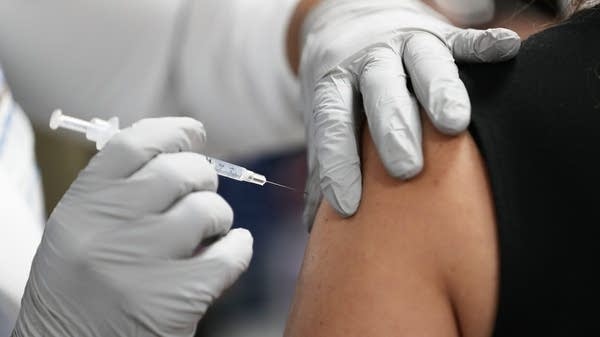Flu, your days are numbered.

The COVID-19 vaccines from Moderna and Pfizer are, in many ways, modern miracles. As you know by now, they were developed using technology called messenger RNA, or mRNA, which basically gives the body instructions to create antibodies for the novel coronavirus.
It’s the first time a vaccine has been developed in this way. And now that we have this technology, we can start using it on all kinds of viruses, like the flu. I spoke with Andrew Hessel, a geneticist and microbiologist. He co-founded the Genome Project-write, an international research effort. The following is an edited transcript of our conversation.

Andrew Hessel: Because mRNA vaccines ultimately use our bodies as a pharmaceutical plant, we can target essentially any virus where we can make any type of an antibody to it. And so it opens up the possibilities for making vaccines for emerging short-term viruses, like Zika, even Ebola. But I think the one that will get really targeted in the short term is simply flu. We have an annual flu season that, for the last 100 years, we haven’t been able to get ahead of. And I think this is the technology that finally puts the nail in the coffin.
Molly Wood: We think about viruses as part of life. But how big a deal is it to imagine that we could target this many viruses so precisely in the future?
Hessel: I think it’s a total game changer. Not just because this is a disease that causes suffering and death, but it’s been the biggest economic push. We realized how important it is to have some sort of bioprotection now in the world because we’ve never had a multitrillion-dollar effect knocking on from an outbreak.
Wood: And we’ve never been forced to think maybe about a virus in terms of global economic impact and national security in the same way?
Hessel: Exactly. We’ve tended to put outbreaks and pathogens into the health bucket. And I think now moving forward, we’ll start to look at it as part of national defense.
Wood: In fact, I understand you think the military could end up being a big buyer of mRNA and synthetic-biology technology in the future, right?
Hessel: They’re already looking to next-generation technologies because today to make the mRNA vaccine, you need a lot of different pieces and players and production facilities. DARPA, the Defense Advanced Research Projects Agency, that kind of develops the next-generation technologies, has already started looking at how they can put the entire drug factory into the field, so that they can turn around this type of vaccine in just a few days, pretty much anywhere.
Wood: It seems a little frustrating that we are on the frontier of this massive breakthrough in terms of vaccines at a time when global vaccine hesitancy also seems to be on the rise. Like is there a marketing hurdle here?
Hessel: It’s part-marketing, it’s part-education. It boils down to trust. But, I wonder how people that are resistant to vaccines today would feel when they could potentially in a decade have a vaccine printer right in their home, and daily or regular updates to their protections, in much the same way as we get antivirus updates for our computer.
Wood: Tell me more about that because you do think we can see innovation in terms of virus protection in our homes, right? You mentioned this vaccine printer. What else might that start to look like?
Hessel: Well, I think in general, we’re getting better at sensing the life around us, whether it’s microbe or other systems. We’re getting really good at sensor technologies. But we did have a gap when it came to viruses. We were pretty blind at the beginning of COVID-19 to how the disease was spreading in our societies. I think those days are over. I imagine there’ll be significant investments now in testing and monitoring technologies. And the type of technologies that we can use for monitoring includes complete sequencing of the virus. That information is basically raw fuel for producing vaccines that are tailored to that organism. So we can start to see a path where we have really precise detection, computational tools for automatic analysis and driving a design process that can produce vaccines, which are preventative or therapeutic for acute disease, pretty much as a value chain. And I think that’s just going to lead not only to better public health, better medicine, but the national defense against Mother Nature and other threats that we clearly have been lacking in the past.
Wood: There’s a world in which we have a virus detector, kind of like a smoke detector. We have a vaccine printer that can pretty quickly sequence the genome of the virus that’s been detected, create a vaccine for it, pump it out, and we take it and we have almost like close to real-time virus protection?
Hessel: I think that’s where we’re heading. Of course, it won’t happen overnight. But the DARPA program is looking for a turnaround time for similar capabilities on the order of three days. I think that’s achievable.
Wood: As this process gets better, and now that this technology is in the pipeline, so to speak, will it also become more equitable? Will it become way cheaper and easier to develop vaccines, meaning that they can be distributed to the developing world more easily and faster?
Hessel: I think the way you have to look at the future of vaccines is to look at the cellphone. The cellphone now outnumbers people. I think that the technology that we’re developing now to detect viruses, to design vaccines and ultimately produce vaccines will be the size of a cellphone, and it will be accessible globally.
Here’s a Wall Street Journal article about how Pfizer, which was first out of the gate with one of these vaccines, is already planning to develop new vaccines, investing heavily in research and development and hiring up to 50 people. The company hasn’t said which vaccines it will work on. Pfizer already makes, according to the Journal, a very popular pneumonia vaccine. And, of course, developing new kinds of vaccines for all kinds of viruses will take investment, as we mentioned. The Journal notes that Pfizer said it’ll bring in about $15 billion this year from the COVID-19 vaccine, which is a pretty good incentive for it and other companies and governments.
And to be clear, I did also ask Hessel what the downside of this technology might be, because I know what you’re thinking: Isn’t this the opening scene of “I Am Legend”? And he said yes, if it’s supereasy to create a vaccine for a virus, it’s also supereasy to create a virus, and obviously that could end badly. But for now, let’s focus on the good news.